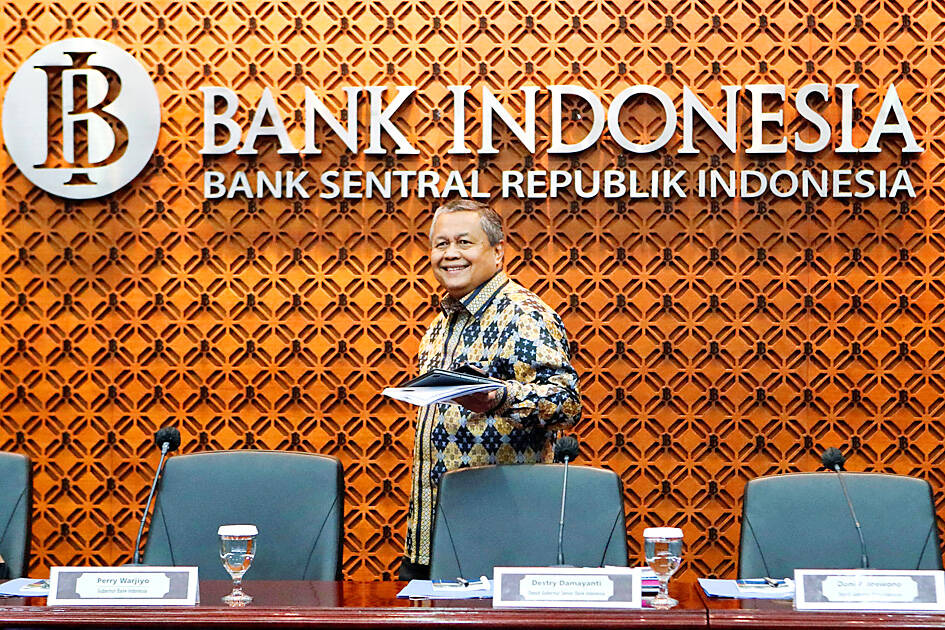Just as the pace of Indonesia’s economic growth returned to pre-COVID-19 pandemic levels, a slowing global economy has emerged as the biggest threat to sustaining that performance.
GDP growth accelerated 5.31 percent last year, bringing Southeast Asia’s largest economy back to its pre-pandemic trajectory of about 5 percent annual growth. That was also the fastest pace since 2013, data yesterday showed.
The “impressive” pace of growth last year was largely supported by domestic consumption, as Indonesia saw a rebound in mobility and tourism, Indonesian Central Statistics Bureau head Margo Yuwono said in a briefing yesterday.

Photo: REUTERS
This was bolstered by exports, as the global commodity rally lifted prices of key shipments such as coal, palm oil, iron and steel, he said.
Although the official forecast is for growth of 4.5 percent to 5.3 percent this year, mounting global risks mean the actual performance could be toward the midpoint, if not lower.
Economists in a Bloomberg survey predict this year’s growth to slow below the psychological 5 percent level to 4.9 percent.
Slowdown in some advanced economies is a key risk. Although the IMF last month raised its forecast for the global economy for the first time in a year, growth in advanced nations is expected to remain weak, damping trade in emerging markets, especially Asia.
Indonesia, the world’s largest exporter of palm oil, saw exports growth tapering in the final months of last year.
That suggests the economy is unlikely to see a repeat of last year’s commodity windfall, which helped lift full-year exports to a record.
“Globally, high prices of Indonesia’s main export commodities supported trade performance last year,” Yuwono said. “However, global commodity prices are already in downward trend, hence will impact growth going forward.”
That is in line with the Indonesian Ministry of Finance’s outlook that weakening global economic activity and higher interest rates could weigh on the nation this year.
The warning signs were apparent in the fourth-quarter figures, with GDP growth at its slowest pace in more than a year.
While exports expanded 15 percent year-on-year, it was softer than the 19.4 percent jump in the July to September period. Consumption growth saw a similar softening to 4.5 percent from 5.4 percent.
Moderating growth means Bank Indonesia, which has increased borrowing costs by 225 basis points since August last year, could be on the verge of its last interest rate increase when it meets later this month.
Bank Indonesia Governor Perry Warjiyo last month indicated that risks from a slowing global economy likely outweigh challenges from inflation, as the central bank slowed the pace of its rate move to a quarter-point.
Headline inflation, which was above the central bank’s 2 percent to 4 percent target for most of last year and likely weighed on consumption, is already showing signs of cooling as gains eased to 5.28 percent last month.

Taiwanese suppliers to Taiwan Semiconductor Manufacturing Co. (TSMC, 台積電) are expected to follow the contract chipmaker’s step to invest in the US, but their relocation may be seven to eight years away, Minister of Economic Affairs J.W. Kuo (郭智輝) said yesterday. When asked by opposition Chinese Nationalist Party (KMT) Legislator Niu Hsu-ting (牛煦庭) in the legislature about growing concerns that TSMC’s huge investments in the US will prompt its suppliers to follow suit, Kuo said based on the chipmaker’s current limited production volume, it is unlikely to lead its supply chain to go there for now. “Unless TSMC completes its planned six

Power supply and electronic components maker Delta Electronics Inc (台達電) yesterday said second-quarter revenue is expected to surpass the first quarter, which rose 30 percent year-on-year to NT$118.92 billion (US$3.71 billion). Revenue this quarter is likely to grow, as US clients have front-loaded orders ahead of US President Donald Trump’s planned tariffs on Taiwanese goods, Delta chairman Ping Cheng (鄭平) said at an earnings conference in Taipei, referring to the 90-day pause in tariff implementation Trump announced on April 9. While situations in the third and fourth quarters remain unclear, “We will not halt our long-term deployments and do not plan to

‘SHORT TERM’: The local currency would likely remain strong in the near term, driven by anticipated US trade pressure, capital inflows and expectations of a US Fed rate cut The US dollar is expected to fall below NT$30 in the near term, as traders anticipate increased pressure from Washington for Taiwan to allow the New Taiwan dollar to appreciate, Cathay United Bank (國泰世華銀行) chief economist Lin Chi-chao (林啟超) said. Following a sharp drop in the greenback against the NT dollar on Friday, Lin told the Central News Agency that the local currency is likely to remain strong in the short term, driven in part by market psychology surrounding anticipated US policy pressure. On Friday, the US dollar fell NT$0.953, or 3.07 percent, closing at NT$31.064 — its lowest level since Jan.

The New Taiwan dollar and Taiwanese stocks surged on signs that trade tensions between the world’s top two economies might start easing and as US tech earnings boosted the outlook of the nation’s semiconductor exports. The NT dollar strengthened as much as 3.8 percent versus the US dollar to 30.815, the biggest intraday gain since January 2011, closing at NT$31.064. The benchmark TAIEX jumped 2.73 percent to outperform the region’s equity gauges. Outlook for global trade improved after China said it is assessing possible trade talks with the US, providing a boost for the nation’s currency and shares. As the NT dollar